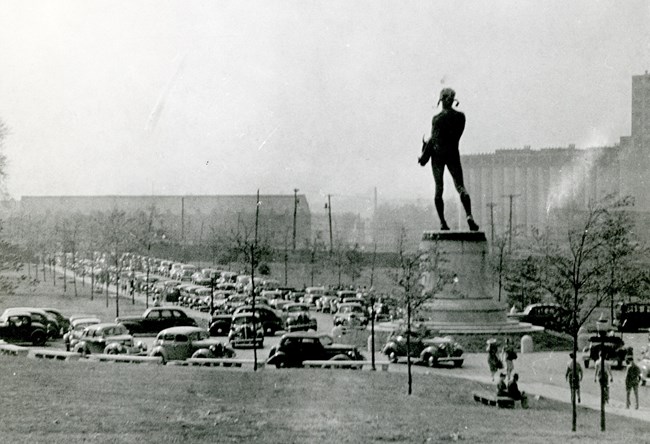

HistoryIn 1914, Congress appropriated $75,000 for a monument at Fort McHenry to mark the centennial of the writing of “The Star-Spangled Banner” and the defense of Baltimore. A national competition was held by the “Fine Arts Commission” on May 28, 1916. One of the 34 entries was a design by Charles H. Niehaus. His work, called Orpheus with the Awkward Foot was chosen.There was a delay erecting the statue due to World War I. Finally, the statue was completed and a dedication was held on Flag Day, June, 14, 1922. The ceremony was attended by President Warren G. Harding. The statue was originally placed in the middle of the entrance road with a circular drive around it. In 1962, Orpheus was relocated to the present site. The MonumentThe monument consists of a 15-foot high circular base made of white marble. Decorated with a frieze in low relief, the base is surmounted by a 24-foot high figure of Orpheus in bronze, shown playing a five-stringed tortoise-shell lyre. The frieze starts with a portrait shield of Key and the dedication, then continues around the drum of the base with a representation of the classic muses paying honor to the army and navy.Work started on November 4, 1920 and was completed on June 1, 1922 as the bronze statue was lowered onto the pedestal. In 1928, Congress compensated Charles Niehaus for $33,121 in cost overruns. The SculptorThe sculptor, Charles H. Niehaus was born in 1855 in Cincinnati, Ohio. He was an influential late 19th century neo-classical sculptor. His early training was at the Royal Academy in Munich, Germany. He also studied in Rome, Italy.He returned to the United States in 1885 and by the 1890’s he was in constant demand as a sculptor. His work on the doors of the Library of Congress in Washington and his Astor Memorial doors of Trinity Church in New York City helped establish his reputation. He expressed a very reformed and pure naturalism which was much in demand. There was so much interest in his work that he was awarded more federal commissions than any other sculptor. The MythologyThe son of a king of Thrace and the muse Calliope, Orpheus was the artful poet, musician and singer of Greek Mythology. His beautiful, young bride was Eurydice.Eurydice would shortly have the misfortune of stepping on a snake and dying from the venom. With his lyre, Orpheus went to the Underworld to plead with its ruler, Hades, for her release. With his sweet music he was able to persuade Hades to release Eurydice. Hades agreed that Eurydice could return on one condition: that Orpheus should not look at her until both had left the Underworld. He guided his wife through the dark with the music of his lyre. But his longing to look at her overcame him. He turned to embrace her, only to see her slip back into Hades. The Mable BaseThe marble base bears a medallion honoring Francis Scott Key, flanked by a procession of allegorical figures. The pedestal contains a time capsule filled with documents of patriotic and historical interest. Although the time capsule was opened in 1962, there are no plans to open it in the future.The inscription on the base reads:
|
Last updated: July 14, 2025
